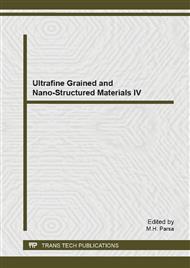p.461
p.466
p.471
p.476
p.482
p.487
p.492
p.497
p.505
Increasing the Performance of Machinery Tools by Super Hard Nanostructured Materials Reinforced with Nanoporous Aluminium Oxide
Abstract:
The use of nanostructured thin films to improve physical and mechanical properties of cutting tools have been recently achieved wonderful progress in industrial and research centres. In this present work, anodic aluminium oxide (AAO) film is formed on the cutting tool by anodizing a thin film of aluminium foil. Aluminium coating is performed using an innovative electroplating method. Then the nanometric pores which are formed by the anodizing are filled with the resistant AlTiN using physical vapour deposition (PVD) method. This procedure results in a nanostructure with an aluminium oxide resistant texture which attains a high hardness and Young modulus. In this project we succeeded in designing aluminium oxide nanostructured as scaffolds for aluminium titanium nitride. Along with nanostructured alloy AlTiN, a unique hardness and wear resistance is obtained. This coating texture improvements the efficiency and tool life much better than other coating methods done, and as a result, a greater efficiency in production and reduction in costs is achieved.
Info:
Periodical:
Pages:
482-486
Citation:
Online since:
November 2013
Authors:
Price:
Сopyright:
© 2014 Trans Tech Publications Ltd. All Rights Reserved
Share:
Citation:


